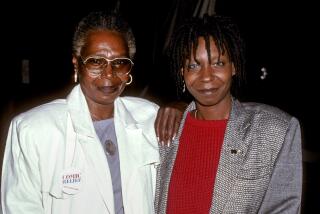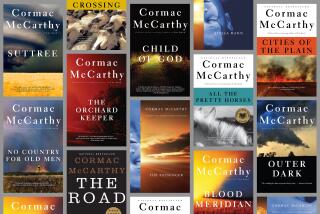Good Gossip Never Goes Stale : Fresh dish on the 48-year marriage of a Russian literary giant and his tormented wife : LOVE AND HATRED: The Stormy Marriage of Leo and Sonya Tolstoy, <i> By William L. Shirer (Simon & Schuster: $25; 400 pp.)</i>
The aggrieved 48-year union of Leo and Sonya Tolstoy, whose own way of unhappiness remains singularly compelling even in an era of instantaneously disseminated scandal, has provided an inexhaustible mine of psychological speculation, literary analysis and plain gossip for more than a century.
“Love and Hatred,” by the late journalist and historian William L. Shirer, is the most recent--though it surely will not be the last--exploration of the marriage between the Russian literary giant and his tormented (and tormenting) muse-amanuensis-wife. The marriage was a disaster from the beginning, when Tolstoy insisted that the 18-year-old Sonya read his diary detailing extensive premarital sexual adventures, to the end in a rural railroad stationmaster’s house where the 82-year-old genius died after fleeing home and wife.
Shirer, the author of 15 other books--”The Rise and Fall of the Third Reich” remains his best-known work--completed his account of the Tolstoy marriage in 1993, shortly before his death at age 89. As the author notes in his forward, he began the book “as an inquiry into why Leo Tolstoy’s long and productive life ended as it did: strangely, irrationally, and in tragedy.”
In a purely factual sense, there would seem to be little need for such an inquiry. The profound emotional and philosophical fissures in Tolstoy’s character, reinforcing and reinforced by the struggle that was his marriage, afford an explanation for his end that is not only sufficient but also overdetermined. In his magnificent “Lectures on Russian Literature” (1988), Vladimir Nabokov offers a brief sketch that casts more light on Tolstoy’s contradictions than all of the bloated biographies of the great man:
“His appetites constantly led him astray from the quiet country road that the ascetic in him craved to follow as passionately as the rake in him craved for the city pleasures of the flesh. . . . (B)eginning in the late seventies, when he was over forty, his conscience triumphed: the ethical overcame both the aesthetic and the personal and drove him to sacrifice his wife’s happiness, his peaceful family life, and his lofty literary career to what he considered a moral necessity: living according to the principles of rational Christian morality--the simple and stern life of generalized humanity, instead of the colorful adventure of individual art.”
In an imaginative sense, Tolstoy’s latter years and his final flight--far more tragic for the rejected Sonya than for her husband--offer considerable material for reflection on the part of anyone who is interested, as Shirer obviously was, in the passions of old age.
Several reviewers have criticized Shirer for focusing on the period after the publication of “Anna Karenina” in 1877, when Tolstoy, then approaching 50, steadily became more of a preacher than an artist--and when the split between his sensual nature and his moral disgust at the act of sex grew even more pronounced. (Tolstoy’s shame did not, however, prevent him from continuing to have sex with his wife, whom he impregnated 16 times.)
It is understandable that contemporary readers should prefer the younger Tolstoy, the author of “War and Peace” and “Anna Karenina.” Without the art, after all, Tolstoy becomes just another bearded Russian prophet--one whose misogyny turned life at Yasnaya Polyana, his country estate, into a genuine hell for the woman who was expected to serve his genius. However, Shirer does an admirable job of demonstrating that Tolstoy was all of a piece.
Throughout most of their lives, Leo and Sonya read each other’s diaries by mutual consent. Two highly intelligent people, both aware that Sonya had been traumatized by the revelations in Leo’s premarital diaries, they continued to torture each other with intimate disclosures that would be likely to destroy any marriage in any era.
As Shirer points out, the Russian publication of the definitive edition of Sonya’s diaries in 1978, followed by an English translation in 1985, has substantially altered what was once the prevailing view of the Tolstoy marriage. In scrutinizing the marriage of a male genius, pre-feminist scholars were basically uninterested in the woman’s side of the story. Shirer does not make that error.
Drawing on diaries that have been extensively cited in recent years by other biographers (of both Tolstoys), Shirer nevertheless selects excerpts that illuminate the particular nature of the mismatch.
In 1985, the Tolstoy’s youngest child, Vanya, died at age 7. On Feb. 23, Sonya recorded that her “darling little Vanechka died this evening at 11 o’clock. . . . My God, and I am still alive!” Sonya did not write in her diary again for more than two years, when she observed that she had closed both her diary and “my life, my heart, my feelings, my joy.”
Tolstoy expressed a very different view after Vanya’s death. “The death of Vanechka was for me . . . a manifestation of God, drawing me towards Him.” A few weeks later, the concerned husband criticized his wife on the ground that she had “invested all her spiritual energies in animal love for her little one.” Predictably, Sonya was enraged when she read the passage. Tolstoy, that Job’s Comforter, continued to offer moral lectures instead of compassion.
After this failure of empathy, it is not such a long distance to the railroad station at Astapovo, where a photographer snapped a pathetic picture of Sonya (reprinted in the book), barred from the bedroom of her dying husband, with her face pressed against the window.
By the end of this account, one can only conclude that the “irrational” circumstances of Tolstoy’s death were no more irrational, or tragic, than the preceding marriage.
Shirer offers no elegy of his own. Instead he quotes the Tolstoys’ daughter, Tanya, who described her parents as “intimately close to one another and infinitely far apart. . . . And who will take it upon himself to call one of them guilty?”
More to Read
Sign up for our Book Club newsletter
Get the latest news, events and more from the Los Angeles Times Book Club, and help us get L.A. reading and talking.
You may occasionally receive promotional content from the Los Angeles Times.






